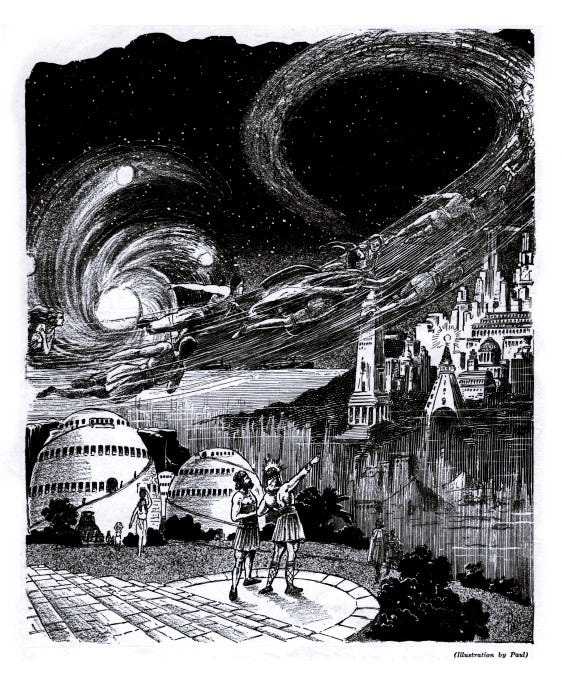Time travel is an evergreen subject in science fiction and science fantasy. Writers find endless delight in imagining the perfect scenario—whether it’s meeting with some long deceased person, visiting an ancient place, or trying to change the past for good or ill.
The most common vehicle of transport is the ubiquitous time machine. These can run the gamut from a simple box to a highly complex machine with mechanical fail-safes, communication devices, and ways to yank the time traveler back if things get too dicey. Some of these apparatuses can also shoot you sideways in time, to parallel dimensions. Sometimes this happens accidently, causing travelers to become highly confused in amusing ways.
But that’s not all. There are other ways to “get from here from there” and some of these are quite ancient. We hear of techniques for consciousness travel in age-old religions and metaphysical practices. Some of these require the use of special hallucinogenics such as Peyote, while others rely on sound, fasting, extreme hardship, or mutilation to achieve an altered state of consciousness. Focused meditation is widely practiced today and can lead to states of expanded awareness necessary for astral and etheric travel. Lucid dreaming is another vehicle for expanded consciousness.
I have written about time travel many times. My first (unpublished) novel was a time travel story. I currently have two stories in print which include consciousness travel: Anchor and Incorruptible. As a life-long meditator, when writing about consciousness travel or the effects of consciousness shifts in my stories, I’m relating some experiences that I have had personally. Not that I have the kinds of science fiction adventures that my characters do, but there are elements of similarity.
My Time Keepers (see the earlier post, “Who are the Time Keepers?”) use several methods of travel which we will learn more about in forthcoming books. Primarily, they use consciousness travel to alter their vibrational rates in order to “walk the time roads.” This describes traveling to parallel dimensions or to different time zones. They can also alter their bodies through the use of a Time Arch allowing them to safely reside for longer periods in lower dimensions. To them, travel between different time zones, parallel dimensions, and teleportational hops are all the same, requiring shifts of location through focused will.
Of course, I’m not the first science fiction writer to pen stories about consciousness travel. Tales of mystical travel were seen more than a hundred years ago. Edwin L. Arnold’s Lieut. Gulliver Jones: His Vacation (aka. Gulliver of Mars) came out in 1905. In it, Jones travels inexplicably to Mars, a beautiful realm of fairy-like folk. There is no time machine, he just wakes up there.
Edgar Rice Burroughs relies on a similar method to transport all his Earthly heroes to Barsoom/Mars. Their bodies remain on Earth, asleep in a coma-like state, while their consciousnesses (along with an alternate body) appear on Mars. John Carter’s adventures begin in Under the Moons of Mars, serialized in All-Story Magazine in 1912. They were subsequently published as a novel in 1917, becoming A Princess of Mars.
David Lindsay’s A Voyage to Arcturus (1920) is somewhat more disturbing in its imagery than either Arnold’s or Burroughs’s books. Lindsey is not a superb writer and his novel reads like something out of the late Victorian age. However, it is interesting and dreamlike and has become a cult classic.
Better examples of consciousness travel stories are seen in John Taine’s The Time Stream, serialized in Wonder Stories, 1931-1932 and Olaf Stapledon’s wonderful, “Star Maker” in 1937.
Catherine Lucille Moore does a lovely job with the subject in Tryst in Time (Astounding Stories, 1936).
Henry Kuttner & Arthur K. Barnes (writing together as “Kelvin Kent”) play the idea for laughs in the Pete Manx series, published in Thrilling Wonder Stories from 1939-1944.
H. Beam Piper seemed fascinated by time and parallel reality stories and tackles the idea of consciousness travel in Time and Time Again (Astounding, 1947). Please note that if you’re looking for this story, keep in mind that they changed the ending when it was performed on the radio show, “X Minus One” in Episode 34, January 11, 1956. To me, that change undermines the story’s original theme.
Moving out of the pulp era, Jack Finney uses the idea of consciousness travel in Time and Again (1970). Finney and his book are referenced in the movie, Somewhere in Time (1980) which features time travel to the past through a similar method as is employed in Finney’s books.
The television series, Quantum Leap (1989-1993), also features this type of time travel. Before the credits, a narrator explains, “During a government experiment into time travel, Dr. Sam Beckett finds himself trapped in the past, ‘leaping’ into the lives of different people, sorting out their problems and changing history in hopes of getting back home to the present.” Sam Beckett’s “soul” leaps into the bodies of others while their souls leap into his, residing back in his laboratory of the future.
These are but a few examples of many. Within the field of consciousness travel there are many facets, especially if you include elements from various world mythologies and religions. As an example, if you had a story featuring Tibetan Buddhist ideas of consciousness travel they would seem very different from another relying on Native American traditions.
This is the Rocketeer signing off for today.





